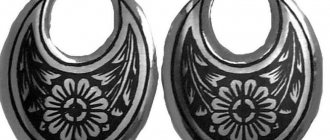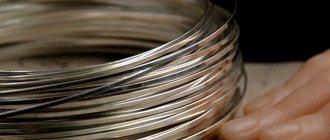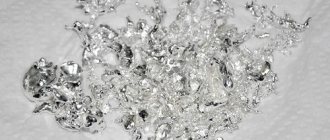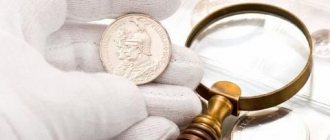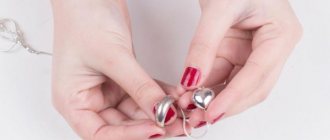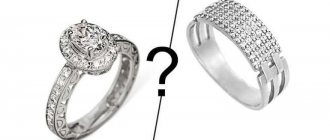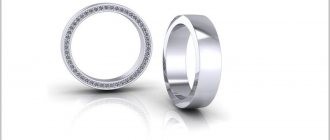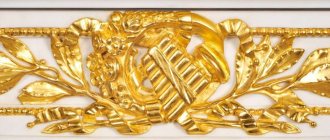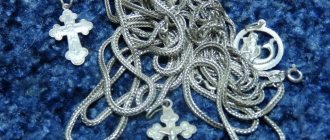Several thousand years ago, a new metal was discovered - silver. And since then, the era of silver jewelry, cutlery and decorative items began. To this day, silver products do not lose their relevance and are as in demand on the market as they were many, many years ago. Even more.
Over time, craftsmen began to discover new facets of metal processing: mixing it with other metals to improve its properties, decorating it with gold and rhodium plating, and using a black alloy to give a black color to the product. This is exactly the method of blackening silver that we will talk about in our article. Let's figure out what blackened silver is, how it is made and why it is valued more than ordinary silver.
What it is
Blackened silver is black-colored silver made using special technology. During the Renaissance, this technique was at the peak of its popularity. Liturgical objects were made from blackened silver and decorated bowls, caskets, knife handles and cutlery handles.
Nowadays, blackened silver has not lost its attractiveness. Small silver items with niello in combination with complex ornaments look interesting in the contrast of colors. There are many different “recipes for preparing” blackened silver, but the meaning of all is the same - to obtain a shade of black, from grayish to deep black.
How to wear blackened silver jewelry correctly
There is a rule that gold and silver are not worn at the same time in the same dress; the same is true with blackened silver - it is an independent decoration and is inappropriate to combine with other metals.
- Blackened silver, like gold, creates its own style; such jewelry should be worn according to the rules.
- Silver bracelets and earrings are suitable for daily wear, for going out, and for celebrations.
- Jewelry looks good with a sporty style; you shouldn’t wear silver.
- Blackened silver is not usually worn to the office or to work; it is more of a decoration for leisure, with the exception of a single bracelet or brooch.
Before purchasing, pay attention to your skin color. For example, those with dark skin are suitable for items made of light silver with dark designs. For those with fair skin, products with silver-icy patterns on a dark background are suitable.
If you liked the article, share it on social networks, it’s important to us
Tags:how to blacken silver at home, What is niello
Varieties of silver
Pure silver has a white color with a silvery tint. But pure silver is too malleable; it cannot be used to make filigree jewelry or a sophisticated box. Therefore, alloys of various metals are added to silver, and depending on the percentage of silver and alloy, the color of the product and its characteristics change. So, today there are several types of silver:
- Matte. They are obtained in different ways: by etching a special emulsion, using a sandblasting machine or a vibroengraver. The product is obtained with a fine-grained rough surface without gloss. Matte silver items look very elegant and unusual. Often such items are chosen as an exclusive decorative gift.
- Coin. Surprisingly, coins were not made from this type of silver, as it might mistakenly seem. Coin silver contains a large percentage of silver (90%) and only 10% copper (rarely nickel or zinc). This alloy composition provides strength and wear resistance to the products. And the name most likely came from ancient times, when people brought silver coins to the master to be melted down. Nowadays coin silver is 900 silver.
- Filigree. This is silver of the highest 960 standard, that is, it consists of 96% silver and 4% alloys of other metals. A thin silver thread is forged from this type of silver and then we form openwork patterns and complex ornaments. Making jewelry from filigree silver is considered a very difficult task, which only true masters can do.
- Blackened. That same silver with the contrast of white and black. Jewelry made from niello looks authentic and sophisticated, and serving items add luxury to any interior. Blackened silver is produced by applying black to pure metal. Next we will look in detail at the methods of blackening silver.
Blackening silver at home
There are many simple home methods for blackening. It happens that you just urgently need to blacken a chain, ring, saucer or vase. As always, the Internet can help us. It is replete with all sorts of recipes: from boiled eggs, which are gentle on the product and do not harm the product, to pharmaceutical sulfur ointment and fixative for attaching photographs. If you choose sulfur ointment, you will need to thoroughly coat the surface with it, then dry it with a hot hairdryer until it drips. When the product turns dark purple, you need to rinse and dry the item.
To blacken silver at home, it is recommended to use iodine. In this case, you won't need a hairdryer. Simply coat the product with iodine, leave it to dry with iodine impregnation, and polish it thoroughly when dry. If you find it difficult to do this yourself, refer to the videos. Keep in mind that blackening is not that easy. Just the preparation of “sulfur liver,” as jewelers call it, is worth a lot. It is very harmful and smelly.
Advantages and disadvantages
Disadvantages can be found in everything, but let's first look at the advantages of blackened silver.
- It may not be as carefully maintained as regular silver. On blackened silver, the dark coating will be completely invisible due to the contrast of colors and complexity of shapes.
- It retains its excellent appearance longer and is highly durable.
- Well, the third advantage is the bactericidal properties of the metal. We have already written about the benefits of silver before. Silver helps destroy pathogenic bacteria and microbes on the surface of the skin.
Blackened silver has no disadvantages, except for one thing - silver with blackened silver cannot be washed in boiled soda solution. To wash the product, you can use any other method of cleaning silver, or simply rinse in soapy water and dry thoroughly.
Blackening methods
As we have already said, there are several methods for producing niello on silver. Since ancient times, craftsmen have come up with and improved ways of applying blackness to silver. In Russia, the peak of popularity of blackened silver occurred in the 17th century, and the city of Veliky Ustyug became its “homeland”. At that time, etching technologies, engraving, etc. were used to apply blackish patterns to silver products. Now the methods remain the same, only the application technique has been improved. Blackening methods can be divided into mechanical and chemical.
Mechanical
The mechanical method involves applying black patterns by hand. For this, a special paste is made from graphite with iron oxide and with the addition of a small proportion of turpentine. Afterwards, the resulting mixture is used to cover the silver object in those places where it is necessary to give a touch of niello. Then let the mixture dry and remove the residue using a suede cloth, after moistening it in alcohol.
In large industries, another method of producing mobile is used - electroplating. Using the galvanic method, a thin surface layer of grayish to black color is obtained. This method is suitable for blackening simple, inexpensive items. Firstly, the black layer will be erased over time, and secondly, this method can only cover the product completely with black and cannot be applied to individual patterns or places.
Chemical
The chemical method of applying black is the most durable and effective and consists of several stages.
- First, the product is prepared. By engraving, chasing or etching, the desired relief pattern is drawn.
- The silver is then sprinkled with a powder of copper, lead, sulfur and manganese or zinc. It is sulfur that gives the black color to the product, therefore the amount of sulfur added to the mixture determines the depth of the color tone of the niello.
- Then they are placed in the oven and heated to the desired temperature. As a result, the powder is fused into the relief of the product and a contrasting silver-black color is obtained.
Modern blackening: liver of sulfur and sulfate film
Blackened silver is not at all the poor relative in the jewelry family. In price per gram, it is significantly more expensive than ordinary silver. But the only way to find that “classical” rabble, as in textbooks, among oxidized silver (numerous, but much less “resistant” relatives of rabble) is to threaten the seller with a silver bullet. It is the so-called “oxidation” that you will most likely encounter in jewelry stores - where the tags indicate “blackening”.
The technique of modern “lightweight” blackening is described in some detail here. Silver alloys themselves are already covered with sulfide and oxide films from interaction with the environment and your body - as a result they darken or otherwise lose their original white luster. That is why store salespeople usually advise customers to take “coated silver,” which is often a thin layer of noble (that is, environmentally resistant) metals—rhodium or ruthenium. Another popular (and fairly inexpensive) way to protect the shine of your products is coating with a thin sulfide film - the same as “oxidation”. In essence, it is an imitation of the natural processes characteristic of silver, but under strict technological control.
For this type of blackening of silver, production technologists prepare a special solution - most often “sulfur liver” from potassium carbonate (potash), sulfur and water (here - more about the composition of this substance). The composition of liver sulfur can be slightly varied to achieve different shades of film. The finished composition is simply applied with a brush to the prepared and cleaned surface of the metal, which must be heated, or, as an option, the product is dipped into it and wait a little while for the desired chemical reaction to occur. It is also possible to blacken using a galvanic method - by passing a current charge through a liquid (electrolyte) in a bath; this method is typical for mass production.
As a result, a durable protective film of the desired shade is formed on the product. The product is washed, areas where blackening is not required are polished (the film is washed), dried - and a finished blackened decoration is obtained.
Sulfate film is quite durable, protects and decorates the product, but there is a limit to everything. “The blackness has come off my ring” - this is precisely about this lightweight look, in contrast to the traditional blackness. In order for the decoration to retain its appearance longer, it needs at least minimal care. One of the gentlest ways to clean jewelry is to fill it with shampoo in a glass and forget about it for a couple of days (perfectionists can use “fairies”). And the good news is that your jewelry can easily be re-oxidized in a jewelry workshop.
Blackening silver at home
There are many simplified, even home-made methods (in case you need to blacken not a vase or dish, but a chain and ring). The Internet is filled with a variety of recipes, from boiled eggs (this method does not harm the inserts in the product) to sulfur pharmaceutical ointment (coat thoroughly, dry with a hot hairdryer until it flows, when it reaches a black-violet color, rinse and dry), or fixative for fixing photographs. It is advised to use iodine (then you don’t even need a hairdryer: coat it with iodine, leave it on the iodine impregnation and polish it after drying). There are also videos. A separate branch snakes around the forum of jewelers, whose texts are similar to the instructions of poisoners. By the way, preparing “sulfur liver” is extremely smelly and harmful.
Metal oxidation
Now you can find oxidized silver in stores, which is passed off as blackened. They may be visually similar, but they differ in quality.
Oxidized silver has the same blackish color, but with uneven filling and is slightly darker than real blackened silver should be.
Metal oxidation is a cheaper way to apply niello to a patterned surface. The product is coated with a thin oxide film, which creates blackness. The thicker the layer, the blacker the pattern will be.
But this method of blackening metal is short-lived. Over time, the film wears off and the item loses its original attractive appearance.
Usage
Blackened silver has never left the fashion pedestal. Years give way to centuries, but the trend for blackened silver remains. This is because, whether it is a sophisticated pendant or a relief bowl, blackened silver gives the products an original, sophisticated appearance.
In addition, such items do not require constant care and cleaning. They are durable and resistant to mechanical damage, do not darken over the years and retain their attractive appearance for a long time.
Now famous designers around the world have blackened silver jewelry, cutlery, home decor items, and even clothing items in their collections. After all, blackened silver is a style and sophistication that will highlight any look.
Product care
Although items made of blackened silver do not tarnish, dirt may well accumulate on them. Therefore, it is recommended to care for it regularly, wash, wipe and dry well.
- A regular soap solution is perfect for removing light dirt and dust from the recesses of the product.
- You can use potato infusion for cleaning. Pour water over the peeled potatoes and let it brew. Then place the blackened silver there and leave it for several hours (up to 4). Afterwards, as always, rinse and wipe.
- Never use harsh or abrasive products, such as ammonia, dry baking soda powder, etc., to clean blackened silver.
- Plus, blackened silver does not tolerate hot temperatures, which means that all methods involving boiling will not work.
- Such items can only be wiped with a soft cloth and stored in a dry, dark place.
How to clean silver from blackening
If at the beginning of the article we told you how to blacken metal, now we will tell you how to get rid of blackening of silver. It is important that we mean the natural blackening of silver over time, and we do not tell you how to rid a product of real blackness.
Place silver jewelry in a pan with baking soda and aluminum foil, or use an aluminum pan and boil for 10 minutes. All the oxide, dirt, dust that has eaten into the openwork inserts from the silver will come off from boiling. This will not happen with real blackened silver.
